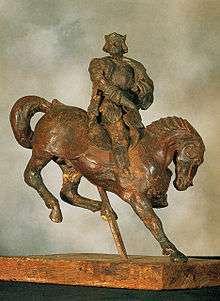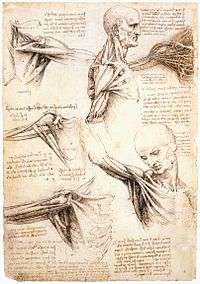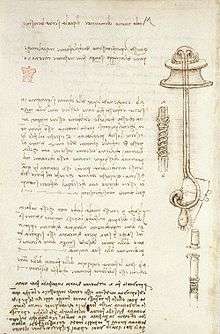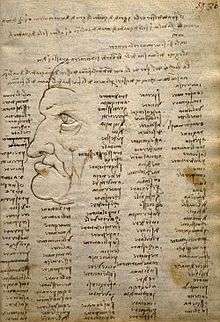List of works by Leonardo da Vinci

Leonardo da Vinci (baptised Leonardo di ser Piero da Vinci) (![]() pronunciation ), (April 15, 1452 – May 2, 1519) was one of the leading artists of the High Renaissance. Fifteen works are generally attributed either in whole or in large part to him. Most are paintings on panel, with the remainder a mural, a large drawing on paper, and two works in the early stages of preparation. The authorship of several paintings traditionally attributed to Leonardo being disputed. Two major works are known only as copies. Works are regularly attributed to Leonardo with varying degrees of credibility. None of Leonardo's paintings are signed. The attributions here draw on the opinions of various scholars.[1]
pronunciation ), (April 15, 1452 – May 2, 1519) was one of the leading artists of the High Renaissance. Fifteen works are generally attributed either in whole or in large part to him. Most are paintings on panel, with the remainder a mural, a large drawing on paper, and two works in the early stages of preparation. The authorship of several paintings traditionally attributed to Leonardo being disputed. Two major works are known only as copies. Works are regularly attributed to Leonardo with varying degrees of credibility. None of Leonardo's paintings are signed. The attributions here draw on the opinions of various scholars.[1]
The small number of surviving paintings is due in part to Leonardo's frequently disastrous experimentation with new techniques, and his chronic procrastination. Nevertheless, these few works together with his notebooks, which contain drawings, scientific diagrams, and his thoughts on the nature of painting, comprise a contribution to later generations of artists rivalled only by that of his contemporary, Michelangelo.
Major extant works
| Image (sort by size of the original) |
Details (sort by title) |
Attribution status and notes | Dating (sort by earliest) |
|---|---|---|---|
| |
Annunciation
|
|
|
| |
Baptism of Christ
|
|
|
| |
Madonna of the Carnation
|
|
|
| |
Ginevra de' Benci
|
| |
| |
Benois Madonna
|
|
|
| |
Adoration of the Magi
|
|
|
| |
S. Jerome in the Wilderness
|
|
|
| |
Madonna Litta
|
|
|
| |
Virgin of the Rocks
|
|
|
| |
Portrait of a Musician
|
|
|
| |
Lady with an Ermine
|
|
|
| |
Virgin of the Rocks
|
|
|
| |
Last Supper
|
|
|
| |
Belle ferronnière
|
|
|
| |
Sala delle Asse
|
|
|
| |
Virgin and Child with St Anne and St John the Baptist
|
|
|
| |
Portrait of Isabella d'Este
|
|
|
| |
Madonna of the Yarnwinder
|
|
|
| |
Madonna of the Yarnwinder
|
|
|
| |
Virgin and Child with St. Anne
|
|
|
| |
Mona Lisa
|
|
|
| |
Head of a Woman
|
|
|
| |
St. John the Baptist
|
|
|
Disputed attributions
| Image | Details | Notes | Dating | |
|---|---|---|---|---|
| |
|
|
| |
| |
|
|
| |
| |
|
|
| |
| |
|
| ||
| |
|
|
| |
|
|
|||
| |
Salvator Mundi
|
|
|
|
| |
|
|||
| |
|
|
|
Lost works
| Details | Notes | Image |
|---|---|---|
|
|
|
|
|
|
|
|
|
|
|
|
|
|
|
|
|
|
|
|
|
Some recent attributions
| Image | Details | Attribution status |
|---|---|---|
|
| |
|
| |
Virgin of the Rocks Cheramy
|
| |
| |
|
|
|
| |
|
| |
|
|
Manuscripts
| Image | Title | Dates | Pages | Notes | Location |
|---|---|---|---|---|---|
| |
Codex Atlanticus | 1478–1519 | 1,119 | 12 volumes, collated by the sculptor Pompeo Leoni. | Milan, Pinacoteca Ambrosiana |
| |
Codex Windsor | 1478–1518 | 153 | Windsor, Royal Collection | |
| |
Codex Arundel | 1480–1518 | 283 | London, British Library | |
| |
Codex Trivulzianus | c. 1487–90 | 55 (originally 62) | Milan, Biblioteca Trivulziana, Castello Sforzesco | |
| |
Codex Forster | 1487–1505 | 354 | Five pocket notebooks bound into three volumes, here listed in chronological order.
|
London, Victoria and Albert Museum |
|
Paris Manuscripts | 1488–1505 | more than 2500 |
12 volumes labeled from "A" to "M", here listed in chronological order.
|
Paris, Bibliothèque de l’Institut de France |
| |
Codex Madrid | 1490s–1504 | Two volumes, rediscovered in 1966.
|
Madrid, Biblioteca Nacional de España | |
|
Codex Ashburnham | c. 1492 | Two volumes, taken out of Paris Manuscripts A and B and sold to the Earl of Ashburnham, who returned them to Paris in 1890. | Paris, Bibliothèque de l’Institut de France | |
| |
Codex on the Flight of Birds | dated 1505 | 18 | Originally part of Paris Manuscript B; probably stolen by Count Guglielmo Libri in around 1840–7.[46] | Turin, Biblioteca Reale |
| |
Codex Leicester | 1506–1510 | 72 | United States, private collection | |
| Codex Urbinas | c. 1530 | An anthology of writings by Leonardo compiled after his death by his pupil Francesco Melzi. An abridged version was published in 1651 as a treatise on painting (Trattato della Pittura).[47] | Vatican City, Biblioteca Apostolica Vaticana |
References
- Sources for attribution status
- ↑ Madonna Litta: Leonardo da Vinci with Giovanni Antonio Boltraffio (Kemp 2011, p. 254); Leonardo da Vinci (Syson 2011); Boltraffio (?) after a design by Leonardo (Zöllner 2011, p. 227)
- ↑ Portrait of a Musician: Leonardo da Vinci (Kemp 2011, p. 254); Giovanni Antonio Boltraffio (?) and Leonardo (?) (Zöllner 2011, p. 225)
- ↑ Buccleuch Madonna: Leonardo da Vinci and an anonymous 16th-century painter (Syson 2011, p. 294); Workshop of Leonardo after a design by Leonardo (Zöllner 2011, p. 239)
- ↑ Lansdowne Madonna: Salaì after a design by Leonardo (Zöllner 2011, p. 238)
- ↑ La Scapigliata: Follower of Leonardo (Syson 2011, p. 198, n. 9); “ascribed today to Leonardo” (Marani 2000, p. 140)
- Citations
- 1 2 3 4 5 6 7 8 9 10 11 della Chiesa, Angela Ottino (1967). The Complete Paintings of Leonardo da Vinci. Penguin. ISBN 0-14-008649-8.
- ↑ Giorgio Vasari, Lives of the Artists, 1568; this edition Penguin Classics, trans. George Bull 1965, ISBN 0-14-044164-6
- ↑ M. Kemp, entry for The Lady with an Ermine in the exhibition Circa 1492: Art in the Age of Exploration (Washington-New Haven-London) pp 271f, states "the identification of the sitter in this painting as Cecilia Gallerani is reasonably secure;" Janice Shell and Grazioso Sironi, "Cecilia Gallerani: Leonardo's Lady with an Ermine" Artibus et Historiae 13 No. 25 (1992:47-66) discuss the career of this identification since it was first suggested in 1900.
- 1 2 Marani 2000, p. 339
- ↑ Kemp 2011, 253
- ↑ Syson 2011, 294
- ↑ Arasse, Daniel (1997). Leonardo da Vinci. Konecky & Konecky. ISBN 1-56852-198-7.
- ↑ Kemp, Martin (2004). Leonardo. Oxford: Oxford University Press. p. 251. The work does not appear in Kemp 2011.
- ↑ Adams, James (October 13, 2005). "Montreal art expert identifies da Vinci drawing". The Globe and Mail. Retrieved 2009-10-14.
- ↑ "The Mark of a Masterpiece" by David Grann, The New Yorker, vol. LXXXVI, no. 20, July 12 & 19, 2010, ISSN 0028-792X
- ↑ For a partial list of scholars who accept the attribution, see Bailey, Martin (31 October 2011). "Leonardo's Saviour of the World rediscovered in New York". The Art Newspaper. Retrieved 21 February 2012.
- ↑ Syson 2011, 302
- ↑ Scaramella, A. D. "Artwork Analysis self Portrait in Red Chalk by Leonardo Da Vinci". Finearts.com. Helium Inc. Retrieved 16 November 2014.
- ↑ "Emergency Treatment for Leonardo da Vinci's Self-Portrait". news.universityproducts.com. Archival Products. Retrieved 16 November 2014.
- 1 2 3 4 5 Marani 2000, p. 431
- ↑ Rubin & Wright 1999, pp. 84 and 118, n. 25
- ↑ Shearman, John (1992). "Only Connect...: Art and the Spectator in the Italian Renaissance". Oxford: Oxford University Press: 33.
- ↑ Delieuvin 2012, cat. 80
- ↑ Delieuvin 2012, cat. 81
- ↑ "St John the Baptist". Your Paintings. BBC. Retrieved 15 July 2013.
- ↑ Arie, Sophie (16 February 2005). "Fingerprint puts Leonardo in the frame". The Guardian. Retrieved 2007-09-27.
- ↑ "A lost Leonardo? Top art historian says maybe". Universal Leonardo. Retrieved 2007-09-27.
- ↑ Bertelli, Carlo (November 19, 2005). "Due allievi non fanno un Leonardo" (in Italian). Il Corriere della Sera. Retrieved 2007-09-27.
- 1 2 3 Stephane Fitch DaVinci's Fingerprints, 12.22.03 accessed 7 July 2009. Martin Kemp, the expert on Leonardo's fingerprints, had not examined the painting when the article was written.
- ↑ A similar image, without the tormentors, is in the Hermitage Museum, St Petersburg.
- ↑ Self-portrait of Leonardo, Surrentum Online, accessed 2010-11-06
- ↑ "'Early Mona Lisa' painting claim disputed". BBC News. 27 September 2012. Retrieved 26 January 2013.
- ↑ "'Horse and Rider' Discovered Leonardo Da Vinci Sculpture". Huffington Post. 14 August 2012. Retrieved 16 January 2014.
- ↑ "Remarkable 500-year-old Leonardo Da Vinci casting of horse and rider unveiled after original was lost for centuries". Daily Mail News. 29 August 2012. Retrieved 16 January 2014.
- ↑ "Leonardo da Vinci's 'Horse and Rider'". BBC News. 28 August 2012. Retrieved 16 January 2014.
- ↑ "The Forster Codices: Leonardo da Vinci's Notebooks at the V&A". Victoria and Albert Museum. Retrieved 4 November 2012.
- ↑ "Paris Manuscript B". Universal Leonardo. University of the Arts, London. Retrieved 3 November 2012.
- ↑ "Paris Manuscript C". Universal Leonardo. University of the Arts, London. Retrieved 3 November 2012.
- ↑ "Paris Manuscript A". Universal Leonardo. University of the Arts, London. Retrieved 3 November 2012.
- ↑ "Paris Manuscript H". Universal Leonardo. University of the Arts, London. Retrieved 3 November 2012.
- ↑ "Paris Manuscript M". Universal Leonardo. University of the Arts, London. Retrieved 3 November 2012.
- ↑ "Paris Manuscript L". Universal Leonardo. University of the Arts, London. Retrieved 3 November 2012.
- ↑ "Paris Manuscript K". Universal Leonardo. University of the Arts, London. Retrieved 3 November 2012.
- ↑ "Paris Manuscript I". Universal Leonardo. University of the Arts, London. Retrieved 3 November 2012.
- ↑ "Paris Manuscript D". Universal Leonardo. University of the Arts, London. Retrieved 3 November 2012.
- ↑ "Paris Manuscript F". Universal Leonardo. University of the Arts, London. Retrieved 3 November 2012.
- ↑ "Paris Manuscript E". Universal Leonardo. University of the Arts, London. Retrieved 3 November 2012.
- ↑ "Paris Manuscript G". Universal Leonardo. University of the Arts, London. Retrieved 3 November 2012.
- ↑ "Codex Madrid I". Universal Leonardo. University of the Arts, London. Retrieved 3 November 2012.
- ↑ "Codex Madrid II". Universal Leonardo. University of the Arts, London. Retrieved 3 November 2012.
- ↑ Bambach 2003, p. 723
- ↑ "Codex Urbinas and lost Libro A". Universal Leonardo. University of the Arts, London. Retrieved 12 April 2012.
- Bibliography
- Bambach, Carmen C., ed. (2003). "Leonardo da Vinci: Master Draftsman". New Haven and London: Yale University Press.
- Chapman, Hugo; Faietti, Marzia (2010). "Fra Angelico to Leonardo: Italian Renaissance Drawings". London: British Museum Press. ISBN 978-0-7141-2667-8.
- Covi, Dario A. (2005). "Andrea del Verrocchio: Life and Work". Arte e archeologia: Studi e documenti (27). Florence: Leo S. Olschki Editore.
- Delieuvin, Vincent, ed. (2012). Saint Anne: Leonardo da Vinci’s Ultimate Masterpiece. Milan: Officina Libraria.
- Kemp, Martin (2006). "Leonardo da Vinci: The Marvellous Works of Nature and Man". Oxford: Oxford University Press. ISBN 978-0-1992-0778-7.
- Kemp, Martin (2011). "Leonardo: Revised edition". Oxford: Oxford University Press.
- Marani, Pietro C. (2000). "Leonardo da Vinci: The Complete Paintings". New York: Harry N. Abrams, Inc.
- Rubin, Patricia Lee; Wright, Alison (1999). "Renaissance Florence: The Art of the 1470s". London: National Gallery Publications.
- Syson, Luke; Larry Keith, Arturo Galansino, Antoni Mazzotta, Scott Nethersole and Per Rumberg (2011). "Leonardo da Vinci: Painter at the Court of Milan". London: National Gallery. Cite uses deprecated parameter
|coauthors=(help) - Zöllner, Frank (2011). "Leonardo da Vinci: The Complete Paintings and Drawings". 1. Cologne: Taschen.
External links
- Leonardo da Vinci and the Virgin of the Rocks, A different point of view
- Web Gallery of Leonardo Paintings
- Drawings of Leonardo da Vinci
- Leda and the Swan copies by Leonardaschi
- Leonardo da Vinci, Master Draftsman, exhibition catalog fully online as PDF from The Metropolitan Museum of Art
- Leonardo da Vinci: anatomical drawings from the Royal Library, Windsor Castle, exhibition catalog fully online as PDF from The Metropolitan Museum of Art
- The Codex Arundel on the British Library's Digitised Manuscripts Website


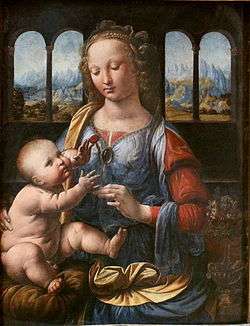
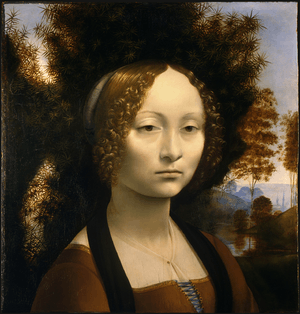
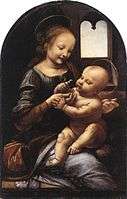
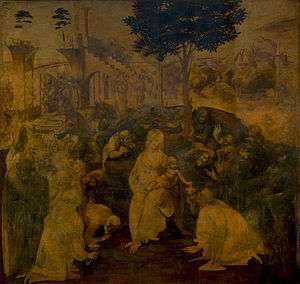

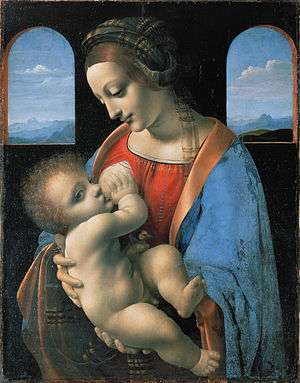
.jpg)


.png)

-_la_Belle_Ferroniere.jpg)




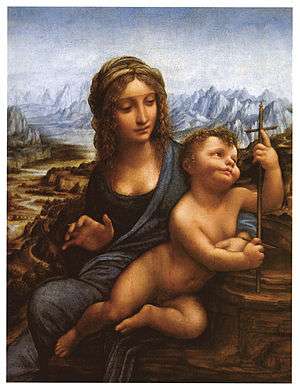


_-_WGA12716.jpg)


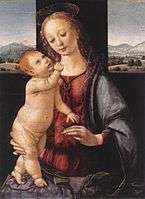
.jpg)
_-_The_Holy_Infants.jpg)

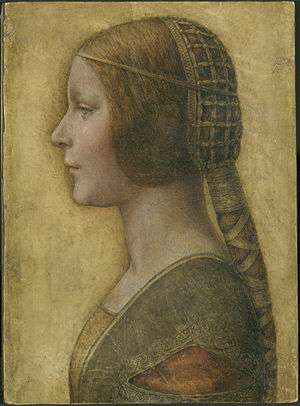
_Salvator_Mundi_circa_1500.jpg)

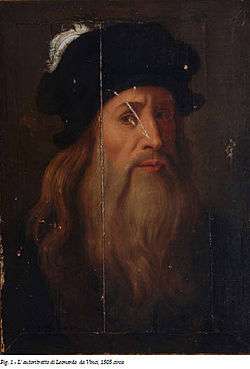
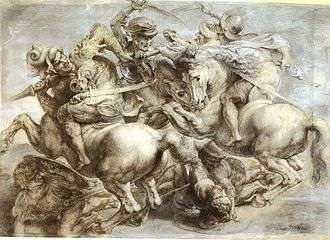
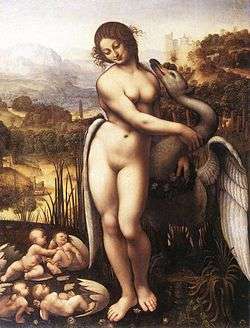
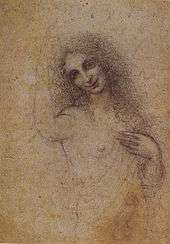
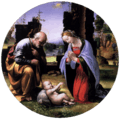


.jpg)


